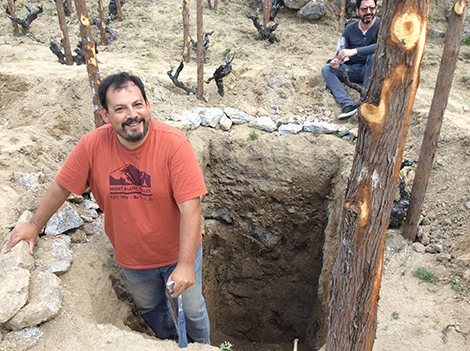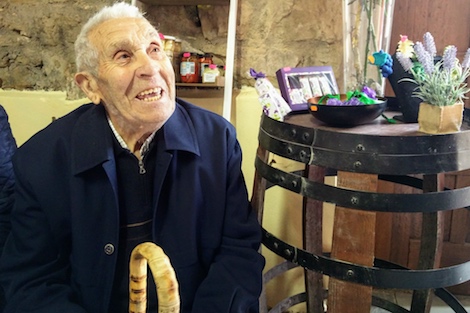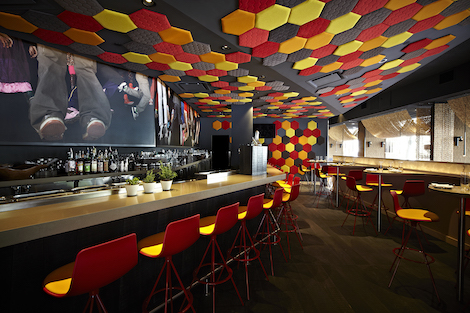
Located in the village of El Tiemblo, Las Iruelas is a fascinating vineyard tended by Daniel Gómez Jiménez Landi (Dani Landi) in Gredos, Spain’s central mountain range one hour north of Madrid. According to Chilean terroir consultant Perro Parra, part of its magic comes from the fact that it stands somewhere between schist and granite. He uses a graphic analogy to explain this: “It’s as if a power cut suddenly stops the microwave.”
On the first Sunday of May, Parra is standing inside a three-meter hole dug right in the middle of the vineyard. “Geology is not mathematical. Sometimes analytics just don’t work. You must focus on how soil, rocks and roots interact.”
I’m part of a group of producers, wine journalists, sommeliers, distributors and importers who lean out onto the pit fascinated by Parra’s unorthodox explanations. He compares the topsoil with his arm’s flesh and the mother rock with the bones inside (“wine can change a lot depending on whether the roots remain in the flesh or reach down to the bone”) and wonders to what “restaurant” roots go to eat at. He’s not really interested in the topsoil (“that’s just a McDonald’s”) but in the Michelin-starred restaurants hidden below. He continues with his restaurant analogy: “The point when you find one of those top-class places is understanding what type of food is served there: Spanish, Italian, Indian?”
Pedro Parra, who holds a PhD in terroir from the Institut National Agronomique de Paris, encourages producers to find out what kind of terroirs they have in order to know who they are. “My work involves understanding if certain terroirs can give the style of wine a producer is looking for”.
Consulting for terroir-obsessed producers
Pedro Parra’s master class was the prelude of the third edition of Fiesta de la Floración (Flowering Celebration), a festival organized by producers Comando G in the heart of Gredos. The programme included an afternoon tasting to mark the 10th anniversary of the winery and a second tasting the day after with Spanish and foreign producers and live music in the vineyards. Parra served his own wines alongside renowned producers he consults for like Burgundy’s Domaine Roulot and close friends like Sebastián Zuccardi’s Cono Sur or Chacra, both from Argentina.
Pedro Parra met Dani Landi and Fernando García, the duo behind Comando G, four years ago. He was introduced to them by Luis Gutiérrez, The Wine Advocate taster for Spain, Argentina, Chile and Jura. “Luis told me that their wines smelled like mine,” Parra recalls. Today Dani and Fernando are close friends rather than clients, as is the case with a considerably large group of producers from America, South Africa, France, Spain and Italy who share similar concerns: “They have met through my consulting work and are highly respectful and caring to each other,” he explains.
Apart from being a winemaker himself, Parra speaks the same language as any terroir-driven producer. He relies on tastings as much as on the information he gets from the pits he digs. There lies the difference with other experts who, according to Parra, “have a thorough knowledge of soils but don’t taste or drink wine.”
Spain’s prodigious terroir potential
Parra marvels at the great diversity of soils that Spain has to offer, surpassing in his opinion those in France or Italy. In terms of soils, ”everything can be done in Spain; it could very well be a Ferrari in the future," he says enthusiastically and believes that "Rioja should be one of the top five atomic terroirs in the world."
To get to that point though, more forward thinking is needed, Parra says. “Spaniards are much more conservative than Italians. While Italians are willing to explore and learn new things, in Spain there are few open-minded producers. The great majority are not fully aware of what is going on in the world of wine.” For Parra, “part of the problem is that the focus is on technique rather than on exploring the diversity of their terroirs.” Like Chileans, “Spaniards lack confidence in what they have”.
To understand terroir intimately, several factors must be considered. Parra cited climate (“the weather sets the rhythm of the music as the orchestra plays deep inside the soil”), fractures and rock components (it’s not enough to know if your soil is sand, silt or clay; you must know its genetics and origin), the degree of rock alteration (in granite soils for instance the level of decomposition is key) or land morphology (concave vs convex). According to Parra, all of these elements are far more important than soil pH which is “just a number”.
After 17 years studying thousands of pits and tasting countless wine samples, Pedro Parra has thoroughly trained his palate. He describes minerality as “a sort of energy or electricity in the texture of the wine” that varies according to the type of soil: “On granite it feels more prominent at the front of your palate, like heavy metal music” against basalt, which is “at the back of the palate” or “deeper, soft and elegant” in limestone.
Minerality-obsessed Dani Landi and Fernando García have managed to grow some of the most extreme, fascinating vineyards in Gredos, yet they were blown away when Parra was able to pair in a blind tasting most of the wines with the vineyards he had previously visited. Landi values greatly Parra’s ability to provide the whys and wherefores behind their terroirs.
Pits, maps and micro-terroirs
Parra’s main working tools are pits and soil maps made with scanners that use electrical conductivity, a technology created for the mining industry that interacts with clay. The combination of pits and maps allows him to demarcate specific micro-terroirs at a relatively small scale.
Take for instance Las Iruelas, a plot with 1,5 hectares in El Tiemblo that Landi bottles under his own name. Aided with eight pits and a map soil, Parra identified three different micro-terroirs which are fermented separately since the 2016 vintage. Rather than producing as many wines as soil units, his aim is to have a comprehensive understanding of the elements that each micro-terroir can add to the wine. According to Parra and Landi, the three cuvées would make a very interesting blend in an outstanding vintage, but under adverse climatic conditions not all of them might convey the style that Landi is looking for.
“I never think of terroir as a single ingredient but as part of a blend,” Parra points out. “In a way, it is like finding out the range of colours available to paint a picture.” That’s why he doesn’t understand winemakers who don’t know his terroir. “A score for a violin played with an electric guitar doesn’t work at all.”
On the other hand, delimiting terroirs is a sort of “liposuction” as it allows producers to discard the areas that don’t fit in with the style of the wine. “To do that you must obviously know your style,” notes Landi.
Six wines, six terroirs
Pedro Parra might have enlightened the knowledge that Dani Landi and Fernando García have of their terroir, but the style of their wines was perfectly defined almost from the start as it was obvious in the tasting. These are our impressions about Dani’s and Comando G’s most distinctive single vineyard wines.
Las Umbrías 2014 Red (Comando G). Located in Rozas de Puerto Real (Madrid), at the entrance of the Tiétar valley, Las Umbrías boasts distinctive granite soils with a relatively high iron content. According to Comando G, the area is marked by the confluence of Atlantic and Mediterranean climates. 2014 was a rainy vintage with up to 200ml registered during the harvest. Very light coloured, almost ethereal but with notable depth, red wild fruits and fresh herbal notes. Delicate but firm. “Las Umbrías is the result of a lot of travelling and money spent on many bottles of Château Rayas in our search to find a floral, delicate expression of Garnacha,” confessed the duo.
El Reventón 2013 Red (Daniel Landi). Grapes are sourced from a 90-year-old vineyard grown at 950m of altitude on shallow, schist soils in Cebreros (Ávila) in the Alberche valley. The climate is Mediterranean, less humid and with good sun exposure. Power, expression and ripeness are present: plums, Mediterranean herbs (thyme) and lots of spices (cinnamon, clove, curry). Broad, juicy palate that makes you salivate; well balanced and ready to enjoy. A sexy, seductive Garnacha.
Rumbo al Norte 2013 Red (Comando G). This breathtaking vineyard featuring huge granite rocks intermixed with the vines is located in Navarrevisca (Ávila), in the Alto Alberche valley. The soils are pure granite with high silt content; 2013 was a “text-book vintage,” according to the winemakers. Medium to light color, slightly reduced at the beginning, this was Comando G’s most concentrated wine showing great potential and lots of (almost painful) minerality. A great wine that will benefit from more cellaring and quite different from the lighter, almost delicate 2016 vintage that we tasted in the vineyard during the morning.
Las Iruelas 2012 Red (Daniel Landi). Aside from what’s been said about this vineyard above, it shares a couple of elements with Las Umbrias: relatively high iron content in the soil and eastern exposure. The scented, intense, almost hypnotic nose developed beautifully along the course of the tasting to strawberry jam, cinnamon and resin aromas. Firm palate with a a refreshing herbal dimension.
Tumba del Rey Moro 2012 Red (Comando G). This is an ungrafted vineyard planted at very high altitude (1,100m) on a steep north-facing slope where vines grow among chestnut trees. Granite soils again, although highly degraded in this case and with high silt content. Light colour. Evocative, fresh nose full of herbs (rosemary, rock roses) followed by a refreshing, juicy palate. This is really delicious and can be enjoyed right now.
El Tamboril 2015 White (Comando G). Located in Navatalgordo (Ávila), Fernando and Dani call this north-facing, moon-like vineyard “the last frontier”. It stands at 1,200 metres above sea level on granite soils with high quartz content. A real mix of white varieties are planted here, but only Garnacha Blanca, Garnacha Gris and Trebbiano Toscano (a real oddity in Spain) make their way into the wine. Fernando and Dani have tried to reflect the sharpness described by Pedro Parra when he studied its soil. Floral, beeswax aromas on the nose are followed by sharp acidity and chalky minerality.

Amaya Cervera
A wine journalist with almost 30 years' experience, she is the founder of the award-winning Spanish Wine Lover website. In 2023, she won the National Gastronomy Award for Gastronomic Communication
NEWSLETTER
Join our community of Spanish wine lovers






